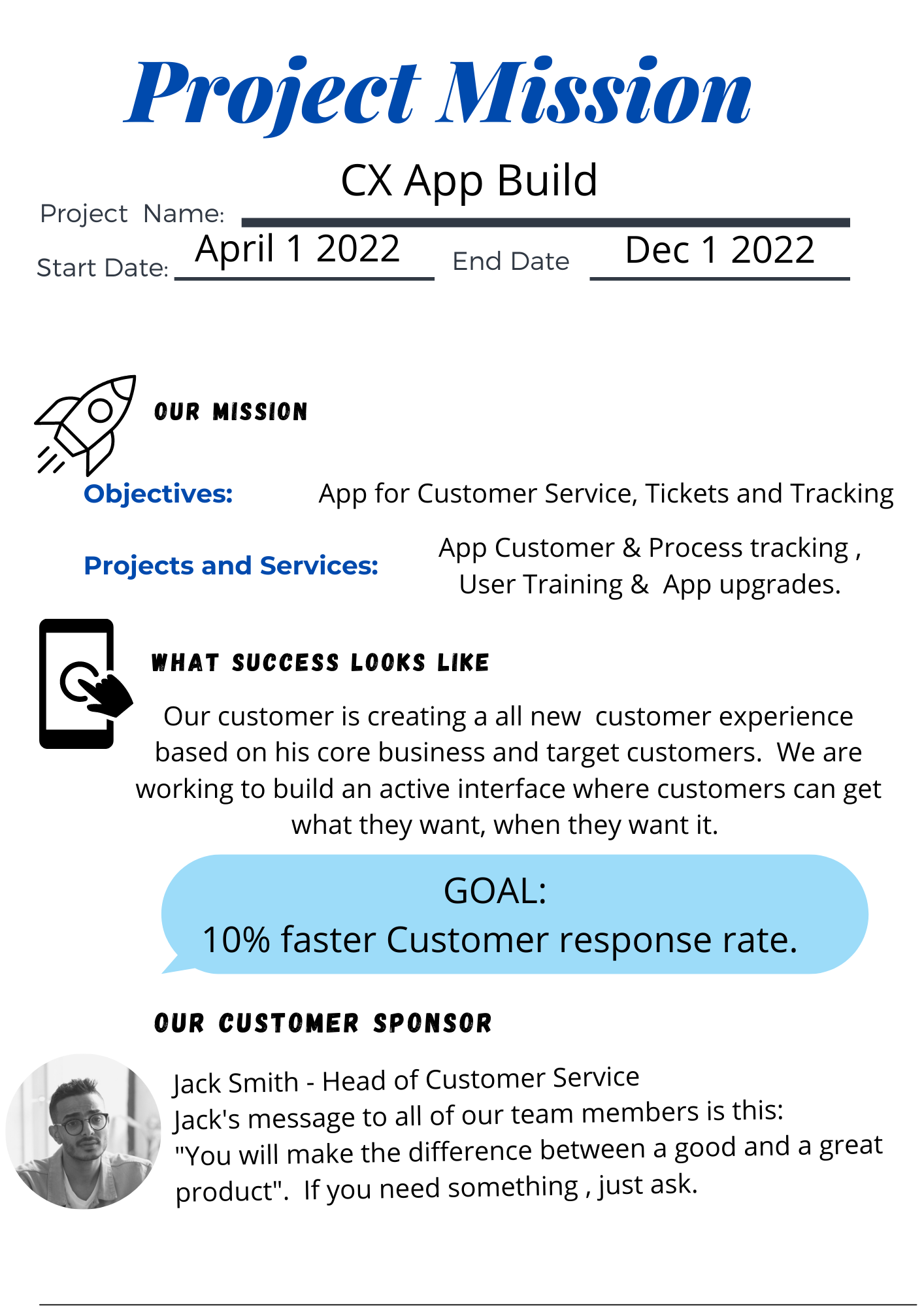How to Onboard a New Team Member
Great teams start with a great hire and onboarding process. Some say the first 90 days are important, and no doubt that is true. But if you want to get new project team members ready to work, you need to focus on the first day and week. Their success will be defined by what is shared ( and what is left out). How connected they feel to the project's mission, team, and outcome.
Good Project Managers make sure onboarding is taken as seriously as the Project Kick-off. Onboarding can happen throughout the project's life, so it is good to create a reusable process. You can see some of my onboarding process in the examples below plus get the free downloadable to Project Onboarding.
This article is part of my PM Fundamentals Series on my Blog. If you want to watch the PM Fundamentals videos, Click here.
5 Steps to Onboarding Project Staff
Engage them with the Project Mission
Share the Team Structure and Processes
Show them how They Contribute
Set them up for Success with a Buddy
Give them a chance to Shine
This list may sound a bit different from what you are used to. Let me explain what I mean and show you how I use my onboarding tool to help create a team member who is engaged, informed, connected, and high-performing.
“Effective onboarding has a measurable Return on Investment (ROI) through decreased turnover costs, increased employee productivity, and improved customer satisfaction. Furthermore, studies have shown that companies that invest in onboarding experience 2.5 times the revenue growth and 1.9 times the profit margin of companies that don't.”
- Tawni Cranz, Chief Talent Officer at Netflix
Depending on the size of your project and the schedule, you may be onboarding new project team members for years. So being consistent and efficient will help you have the biggest impact without costing the project tons of effort.
Because onboarding is so important to the team's long-term success and the project's product or solution) the goal should be that the Project Manager or a related Team Lead should handle staff onboarding. Look for ways to be efficient such as creating a document or videos for reuse. Also, plan to spend at least 1 hour with each new hire to share the key aspects of the project. Personal attention now will set up the new hire for success and allow the team leadership to make a connection before that person gets to work.
1. Engage new team members with the Project Mission
At the start of your project, you likely created a project charter, schedule, and most importantly, a statement about what success looks like. Now is the time to share it with any new team member.
Understanding the project's ultimate goal will help the team member keep the big picture in mind when learning about the project processes and roles. Project Team members can get lost in the details and forget to see the parts of a project as part of an end solution that will benefit the company and the end-users, and the company's customers either directly or indirectly.
But new team members can not know what you don't share. I take a page from my Kick-off guide to share with the new team member to keep it simple. Of course, update the mission summary for any significant changes your project has incorporated. This is a great create once, use often kind of document.
Need help to inspire your team with a story about your project to inform and inspire them?
Watch this video on how to tell a Business Story.
2. Share the Project's Structure and Processes with new members
All new members need to be indoctrinated into the project's way of working. These processes may include rules from the company or client. However, make sure you also focus on the specifics of how the staff works within the project. A good way to do this is to have a document training guide that the new joiner can reference. Remember your goal is not just to inform, but to set each team member up to be great. Get inspiration on making a great team from this video.
There are key things all Project Team members need to know:
How the team works
General documentation and process flows
Specific team document formats and templates
When to use documents and who reviews them
When and how the team meets
The expectations of a high performing team.
Who's on the team
What are the key roles, and who they report
Introduce the team leads
Share how the assigned sub teams work together
How to get help
How will they be trained
Who do they go to for questions
All of the above information can be summarized on this page. However, it also can be helpful for each team lead to take the new member of their team through the details, and, if you have a large project, a short series of videos on training basic content can be helpful.
3. Show new Project team members how They Contribute
It is not enough to explain the project. You have to show the team member how their work contributes to the outcomes. This connection may be direct and obvious for some roles and less obvious for other jobs.
Either way: Say it out loud. If your goal is to create a connection between team members and the project's success, people have to take their work personally (in the best possible way). And as the Project Manager or Team Lead your job is to clarify the message, answer questions and set expectations from day one. Your goal is to share enthusiasm and a sense of responsibility for the shared outcome.
In this example the details are specific to the role, but the format: Activities, KPIs, Tools and go-to contacts is general for every role. In fact, you can use these summaries in your team room with photos of team members. It can be helpful to the Sponsor and Users and makes roles even clearer for team members.
Part of understanding how the team contributes as individuals is to understand the teams structure as a whole. For more information on explaining the dynamics of your teams structure, see this video.
4. Set up new team members for Success with a Buddy
It's often strange to join a project mid-way. Relationships have already been formed, and the team has adopted informal ways of working in addition to the formal processes. So you need a way to help a new people get connected. A Buddy is a good way to start. This person is part of the project team and has a ‘day job’ but is given a time allotment to help others. Buddy’s can help answer questions about the project, share the project culture, help them with practical matters like getting the systems and processes setup. But they also can support on connecting the new person to the rest of the team and helping to build relationships.
A Buddy is that person on your team who has high EQ. Personal skills vary from person to person and team to team. By identifying those team members who naturally help others and formally ''assigning'' them the Buddy role, you give both the Buddy and the new hire a clear signal that this is important and that cooperation is valued and expected. This also raises the status of the Buddy, making this an important sub role for team members to aspire to and be proud of.
At your team-wide meetings, give time for team dynamics, including a shout-out to Buddies and new team members.
The Team Lead, Buddy or Project Manager should walk the new staff through their first day on the job. They can make sure they meet the team, and other key people and get the tools they need to get started.
In addition, make sure that they have lunch with team members and are made to feel at home. This process is important to forming a team that works well together. A point even more important when a new team member joins later.
If you are using the Buddy approach, make sure the Buddy explains their role and checks-in with the new joiner from time to time.
If possible, consider a weekly meet and greet with the team and the sponsor or other key clients and project members.
"..the biggest reason why people fail or underperform has to do with the culture and politics of the organization. How we are going to help this person adapt to the new culture; how are we going to connect them to the right people and help them form the right relationships; and how are we going to be sure that we really align expectations in every direction so that they're set up for success…"
- Michael Watkins, author of The First 90 Days
5. Give new team members a Chance to Shine
No matter the job, everyone wants a chance to shine. So if you can assign new team members to a task working with others. This will help them learn the ropes and have someone to talk to (and maybe someone to talk to at lunch).
After you and your team lead have vetted the new hire, why not give them a chance to shine by taking on a stretch assignment. Ask them to lunch and check-in with them. Ask how they are doing? If they have everything they need? Or, if they have questions or issues? By checking in occasionally with all of the staff at coffee, lunch for after meetings, you let your team know that management is doesn’t play favorites, is engaged and cares.
And let Check-ins be a moment to listen and learn, not a ‘pseudo’ staff meeting. If the person shows interest in taking on an additional assignment, reward the attitude by speaking with the lead and finding something that fits the role and capability of the team member.
"Beyond the challenges of recruitment and retention, productivity is perhaps the most important reason onboarding has taken on such immense strategic relevance for progressive firms."
- Mark Stein and Lilleth Christiansen, authors of Successful Onboarding
When should you onboard?
Onboarding is needed when staff joins, but there are other times when the onboarding process can be useful.
When team members change roles
At the start of every project
If the project changes in some way
A common approach to long-standing Projects or Programs I have used is to have an annual day at the start of the project that is part :
project refresh
onboarding
training
cultural reset
team bonding
How is onboarding a project team different from onboarding an employee?
The Focus: Employees and team members may be the same. However, employee onboarding may include signing up for health and pensions. The focus of the project team is on the project and task onboarding.
The Goal: Project Team members may come from different companies and have varying skill sets and team roles. So understanding the culture and project structure is important to creating a high-performing contributor to the team.
The Timeframe: You will want to take time to onboard a project team member if they contribute to the outcome. Even if they are in short-term roles (3-6months), a temporary employee may not need that kind of focus. The job is ringfenced enough in some cases, so they do not need to understand the big picture. I would not recommend that for a project team member.
I hope you found this information helpful. If you have a question or comment, please leave it below, or sign up on the community contact page to get alerts when I drop another free downloadable.









